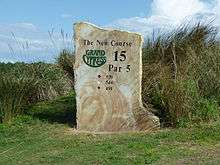Par (golf scoring format)
Par, or Bogey, is a scoring system used mostly in amateur and club golf. It is a match play format played against the course, with scoring based on the number of strokes taken compared to the par or bogey of each hole. In this context, bogey is meant in the traditional sense as the score a good player would expect on the hole, usually par but occasionally one stroke more. The winner of the competition is the player with the highest differential of holes "won" to holes "lost", with the result on each hole normally based on the players handicap-adjusted score.[1][2]

Par has similarities to the popular Stableford scoring system in that competition is against the course on a hole-by-hole basis, and the occasional very bad hole does not massively affect the overall result.[2] Because of this it also has the same advantage of improving pace of play in large club competitions as holing out is not required once the hole is lost. Unlike Stableford however, there is no reward for a handicap-adjusted eagle (or better).[3]
Overview
For ease of explanation, assume a player's handicap gives them one stroke per hole (e.g., an 18-hole handicap of 18). This player, playing to their handicap on a given day, will average a bogey on each hole. Playing 'to' ones handicap is expected and so there is no reward or punishment due when a bogey five is recorded on a par four. Thus, a 0 (zero/half) is recorded. A double-bogey six (one over what's expected from a player on a nine handicap, would incur a penalty of a minus '−' (loss). A four (a genuine, unadjusted par) is one better than a '9-handicapper' would be expected to score and would earn a plus '+' (win). However, for this golfer, sixes and above still incur just one minus '−'. Likewise, fours and below earn just one plus '+'. At the end of the round, pluses and minuses are reconciled (a minus cancels out a plus). If a player finishes with two pluses, they are 'two up' or 'plus two' (+2). The opposite applies if they finish with two minuses − 'two down'; 'minus 2'; '−2'.
References
- "GOLF COMPETITIONS AND HOW THEY ARE PLAYED" (PDF). Golf Australia. Retrieved 16 June 2018.
- Easdale, Roderick (August 11, 2015). "What are bogey competitions in golf?". Golf Monthly. Retrieved December 16, 2019.
- "'Par' Competitions". Fairbairn Golf Club. Retrieved 16 June 2018.